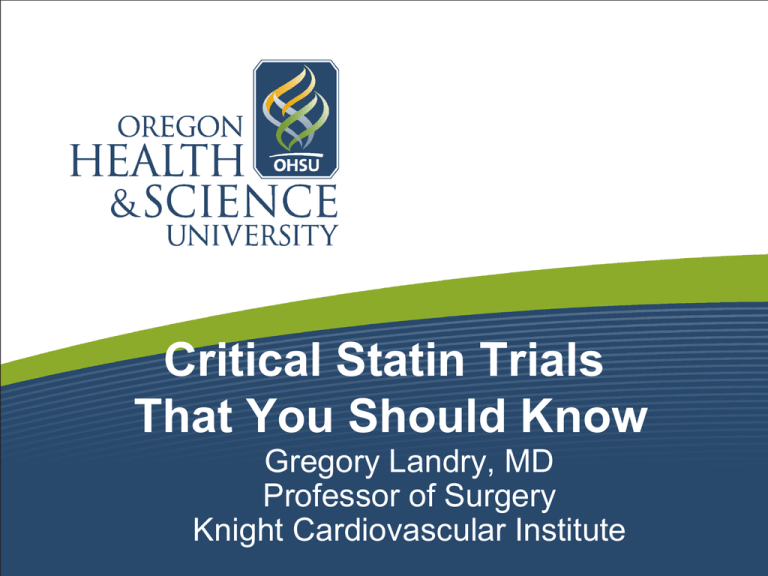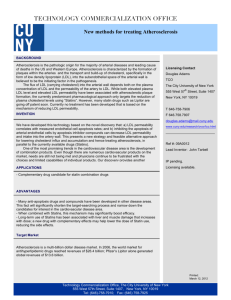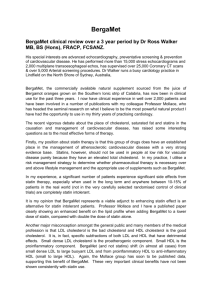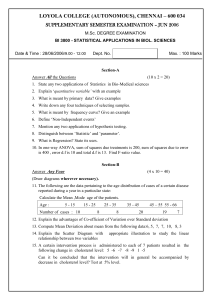Critical Trials Studying Statin Therapy that you should know
advertisement

Critical Statin Trials That You Should Know Gregory Landry, MD Professor of Surgery Knight Cardiovascular Institute • No Disclosures Critical Statin Trials • Statin Guidelines • Secondary Prevention of Cardiovascular disease • Primary Prevention of Cardiovascular disease • Peripheral Arterial Disease • Complications of statin therapy • Future therapies What are statins? • Metabolite of red rice yeast • HMG-CoA reductase inhibitor – Rate limiting step of cholesterol synthesis • Decreased hepatic cholesterol biosynthesis • ↓LDL, ↓TG, ↑HDL Pleiotropic effects of statin Inhibition of G proteins Upregulate nitric oxide synthetase Inhibit cytokine expression in macrophages Prevention of vascular inflammation Inhibit vasoconstriction, promote reendothelialization Atherosclerotic plaque stabilization Cholesterol management Who Should Get a Cholesterol Test • US Preventive Services Task Force – All men >35 – Men and women > 20 with other risk factors (diabetes, obesity, smoking) – Men 20-35, Women >20 without risk factors – no specific recommendation What is available in the US How do statins differ from each other • Lipophilic (atorva, lova, simva), can cross BBB (insomnia) • Drug interactions – Prava less plasma protein binding, less likely to displace plasma bound drugs such as warfarin – Metabolism by different liver enzymes • Food interactions (lova increases with food; atorva, fluva, prava decrease with food) • Atorva and fluva do not need to be adjusted for renal insuff. • Differences in half life, different recommendations on what time of day to take • Different potency although all effective in LDL lowering • Similar safety profiles ACC/AHA Guidelines Stone NJ, et al. JACC & Circulation, 2014 Cholesterol Management • 2014 AHA Guidelines – Statin Therapy Recommended for the Following Groups: 1. People without CV disease, 40-75 yo, ≥7.5% risk of MI/stroke within 10 years 2. People with CV disease (MI, stroke, PAD) 3. People ≥ 21 yo with LDL ≥ 190 mg/dL 4. People with type I or II DM 40-75 yo Heart Risk Calculator • • • • • • • • • • Age Gender Race Total cholesterol HDL cholesterol Systolic blood pressure Diastolic blood pressure Treated for HBP Diabetes Smoker AHA Guidelines • No longer target specific LDL, HDL levels • Prior guidelines – LDL < 100 for primary prevention – LDL < 70 for secondary prevention • Recommend appropriate intensity of therapy for different risk groups Intensity of Statin Therapy High Intensity Moderate Intensity Low Intensity LDL > 190 40-75, LDL<190, >7.5% ASCVD risk DM, 40-75, >7.5% >75, hx ASCVD ASCVD risk <75, hx ASCVD Risk of side effects from high dose: >75, renal/liver, med interaction, Asian Currently on a low intensity statin and doing well on it AHA Guidelines • No longer recommend additional medications (fibrates, niacin) on top of statins to meet specific targets Niacin • • • • • Vitamin B3, nicotinic acid Has been shown to ↑HDL, ↓TG, ↓LDL Requires high doses to be effective Notable side effects (flushing) “No flush” niacin does not have nicotinic acid AIM HIGH • 3400 patients with hx of cardiovascular dz • Simvastatin + niacin vs Simvastatin + placebo • Composite endpoint of MI, stroke, coronary death • Trial stopped early NEJM, 2011 AIM HIGH • Elevated HDL 35 to 42 • Decreased LDL 74 to 62 • Decreased TG 164 to 122 Ezetimibe • Reduces cholesterol absorption in small intestine • Monotherapy (Zetia, Ezetrol) – Limited efficacy (15-20% LDL lowering) • Combination therapy (Vytorin) IMPROVE-IT Cannon, NEJM,2015 • 18000+ patients with ACS • Simvastatin + Ezetimibe vs Simvastatin + placebo • Ezetimibe: reduce GI cholesterol absorption • Slight improvement in death/MACE (32% vs 34%) • Secondary Prevention – CARE – PROVEIT-TIMI – SPARCL CARE: Cholesterol and Recurrent Events • 4159 patients with hx of MI (3-20 months prior to randomization) • US/Canada • Total cholesterol <240 • Pravastatin 40mg qday vs placebo • Primary endpoint fatal coronary event or nonfatal MI Sacks, NEJM, 1996 CARE • Median 5 year f/u • 24% reduction (3% absolute) in MI • 27% reduction (2.5% absolute) in CABG or angioplasty • 31% stroke reduction (0.8% absolute) • Greater benefit in women, non-DM, higher LDL PROVE IT-TIMI 22 • 4162 patients with acute coronary syndrome (<10 days) • US,Canada, Europe • Intensive statin therapy (atorvastatin 80mg po qday) vs moderate statin therapy (pravastatin 40mg po qday) • Composite endpoint death, MI, unstable angina, revasc, stroke Cannon, NEJM, 2004 PROVE IT-TIMI 22 Ridker, NEJM, 2005 • Greater protection against composite endpoint with more intensive statin regimen • Levels of both LDL and CRP were important in MI risk reduction • CRP levels reduced to a greater degree with more intensive statin therapy SPARCL • 4731 subjects with stroke/TIA within 6 months • LDL 100-190 • No history of coronary artery disease • Atorvastatin 80mg po qday vs placebo NEJM, 2006 SPARCL • • • • Absolute risk reduction 2.2% HR 0.84 for ischemic stroke HR 1.55 for hemorrhagic stroke NNTT 46 for five years • Absolute risk reduction 3.5% • HR 0.74 • NNTT 29 for five years Strong evidence in favor of statin therapy for secondary prevention of cardiovascular disease • Primary Prevention – PROSPER – ASCOT – JUPITER PROSPER • 5804 patients age 70-82 • History of or risk for vascular disease • Scotland, Ireland, Netherlands • Pravastatin 40 mg po qday vs placebo • Composite endpoint of MI, CVA, death • 3.2 years mean follow up Shepherd, Lancet 2002 composite MI • 34% reduction in LDL • 5% increase in HDL • 13% reduction in TG • 15% decrease in composite endpoint • 19% decrease MI • No change in stroke – 25% decrease in TIA stroke • Effect more pronounced in men PROSPER • Effects the same for both primary and secondary prevention ASCOT TRIAL Sever, Lancet, 2003 • 10,305 hypertensive patients, age 40-79, with normal fasting cholesterol levels • UK/Scandinavia • Atorvastatin 10mg po qday vs placebo • Primary composite endpoint nonfatal MI and fatal CHD • 5 year intended follow up, trial stopped at median 3.3 years • 36% risk reduction of primary endpoint • No significant benefit in women JUPITER TRIAL Ridker, NEJM, 2008 • ½ of all MI and CVA occur in people with normal cholesterol • 17,802 subjects with elevated CRP but normal LDL • Rosuvastatin (20mg/day) vs placebo • Combined endpoint (MI, CVA, Revasc., unstable angina, CV death) • Trial stopped early JUPITER TRIAL • NNTT 25 at five years to prevent one composite endpoint • Higher incidence of physician reported DM Strong evidence in favor of statin therapy for primary prevention of cardiovascular disease in selected patient populations with normal cholesterol levels Prevalence of PAD Increases with Age Patients with PAD (%) Rotterdam Study (ABI <0.9)1 San Diego Study (PAD by noninvasive tests)2 60 50 40 30 20 10 0 55-59 60-64 65-69 70-74 75-79 Age Group (y) 80-84 85-89 Peripheral Arterial Disease (PAD) Mortality* Survival (% of Patients) 100 Normal Subjects 75 Asymptomatic LV-PAD† 50 Symptomatic LV-PAD† Severe Symptomatic LV-PAD† 25 0 0 2 4 6 8 Year *Kaplan*Kaplan-Meier survival curves based on mortality from all causes. †LargeLarge-vessel PAD. Criqui MH et al. N Engl J Med. 1992;326:381-386. 10 12 Effects of Statins on Peripheral Arterial Disease • Systematic review of trials in which statins targeted to PAD population – Lower all cause mortality – Lower MACE – Lower MALE Statins in PAD: Heart Protection Study • 6748 UK adults with PAD • 13,788 high risk people • 40 mg simvastatin vs placebo • 5 year study • Endpoints – First major vascular event (coronary, stroke, or peripheral revascularization) J Vasc Surg, 2007 Heart Protection Study • 20-25% reduction in vascular events irrespective of initial LDL levels Incremental Decrease in End Points Through Aggressive Lipid Lowering Study: IDEAL • 8888 patients with CAD randomized to high dose (ator) vs low dose (simva)statin • 5 year follow up • Endpoints – No PAD: new diagnosis requiring intervention – + PAD: recurrence requiring intervention Stoekenbroek, Heart –BMJ, 2015 IDEAL Study • 30% decrease in incident PAD events with high dose statin in patients without PAD hx • In PAD patients, significant decrease in overall coronary events and coronary revascularization Claudication • Scandinavian Simvastatin Survival Study • + secondary prevention for MACE • New or worsening claudication decreased with simvastatin Graft patency • PREVENT III Schanzer, JVS 2008 4S, Am J Cardiol 1998 Statin use after endovascular procedures • Retrospective review of 646 patients undergoing endovascular intervention for CLI – 319 statin – 327 no statin Aiello, J Vasc Surg, 2012 • Groups were well matched for demographics, lesion location, lesion severity, and procedure performed (PTA, stent, atherectomy) Statins after endovascular procedures AAA Growth Takagi, EJVES, 2012 Fewer RCT but still good evidence in favor of statin therapy for prevention of cardiac events in people with PAD. May improve PAD symptoms, stent patency, but data less strong Complications Do Statins Cause Diabetes? • Potential for causing type II DM – Increase insulin resistance – Impair ability of pancreas to secrete insulin Statins and Diabetes • 10-12% increased risk of type II DM • NNTT 255 for 1 case DM • Despite increased DM risk, cardiovascular events markedly decreased Statin Diabetes Safety Task Force: 2014 TNT: Treating to New Targets IDEAL: Incremental Decrease in Endpoints Through Aggressive Lipid Lowering • Risk Factors – Fasting blood glucose > 100 mg/dl – Fasting triglyceride level > 150 mg/dl – BMI> 30 kg/m2 – Hx of hypertension Complications in Primary Prevention Trials Finegold, E J Prev Cardiol, 2014 Myalgia • 5-10% incidence in observational studies • Probably underestimated in clinical trials – Based on CPK elevation – Not systematically reported – Exclusion of patients most likely to get myalgias • • • • • Renal insufficiency Liver insufficiency Elderly Drugs (CSA, protease inh, Abx) Hx of muscle symptoms Effect of Statins on Muscle Performance: STOMP Trial • Atorvastatin vs placebo, 6 months, n=420 • Myalgia definition – New muscle pain not associated with exercise – > 2wks duration – Resolved within 2 wks after stopping drug – Recurred within 4 wks after restarting Parker, Circulation, 2013 • Myalgia: Atorvastatin 9%, Placebo 5%, p<0.05 • No difference in muscle strength • Overall no difference in physical activity Recommendations for myalgia • Severe forms rare (>CPK) but mandate alternative therapies • Mild/moderate forms common but rarely mandate stopping drug • 40-90% can reestablish and maintain use with adjusted dosage, frequency, agents What about Coenzyme Q10 (CoQ10)? • Part of the mitochondrial transport pathway • Produced by the cholesterol metabolic pathway • Deficiency may lead to abnormalities of skeletal muscle metabolism Banach, Mayo Clin Proc, 2015 I almost forgot, what about statins and memory loss? • 2012 FDA warning that some patients may develop memory loss on statins • Synapses and glial cells in the brain depend on cholesterol for proper function • Meta analysis of 25 RCT • No adverse cognitive effects Ott, J Gen Int Med, 2015 Current evidence strongly shows that the benefits of statins outweigh risks PCSK9 Inhibitors • LDL cleared from circulation through LDL receptor • PCSK9 is a gene associated with LDL receptor degradation • Prevents LDL clearance • PCSK9 levels elevated 32% by statins (JUPITER) • Inhibiting PCSK9 may augment effect of statins PCSK9 Inhibitors: Phase III trials • Evolocumab: – LAPLACE, DESCARTES, MENDEL,TESLA, RUTHERFORD – Added to statins, ezetamibe or monotherapy – Q2-4 wk injections – 30-75% LDL reduction • Alirocumab: – – – – ODYSSEY With statins, ezetamibe or monotherapy Q2-4 wk injections 50% LDL reduction • Side effects – Allergic reaction at injection site PCSK9 Inhibitors: Barriers to $€££ing • $7000-$15000/year • Likely applications – Familial hypercholesterolemia – Statin intolerance What about red rice yeast? • Lowers LDL due to monacolin K, natural form of lovastatin • 20-30% LDL reduction in RCT • No standardization of levels in supplements • Likely more expensive than generic statins Summary • Strong evidence for statin use in primary and secondary prevention of cardiovascular disease and in patients with PAD • Benefits outweigh risks • AHA guidelines and risk calculators help determine proper patients and intensity of therapy



